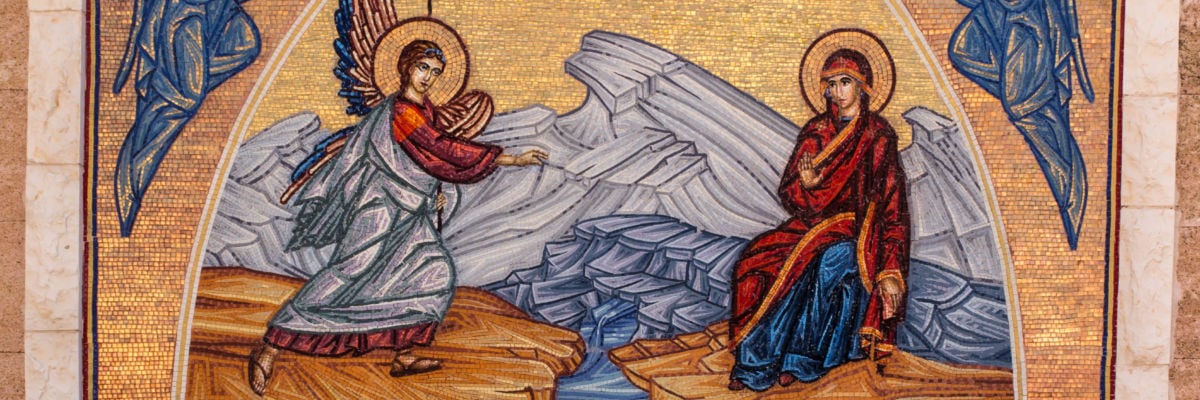
Today is the Feast of the Annunciation, where we celebrate the most impressive sacramental God ever gave us: his own self, in the perceptible form of a human body. It’s the perfect day to explain how, contrary to what a massive chunk of Christians within the USA believe, God really does communicate with us through material things—especially in the sacraments.
This is a truth that needs to be proclaimed everywhere, for we live in an era where people prop up faith and lump baptism and communion in the category of the purely symbolic. But the sacraments, in reality, are comparable to pipes that carry God’s heavenly life to us.
For many, this seems ridiculous. Earthly things like water, bread, wine, oil, episcopal hands, priestly voices, and the voices of a husband and a wife are too lowly for the resplendent Trinity. Yet God truly does operate in these mysteriously earthly actions. There is a good argument to be made for this just from a practical perspective, but also more powerfully from a salvation-historical perspective.
Practically speaking, God made us with five senses, which we use to take in information. God makes sure to speak to us through physical, material things. God created the world “good,” as the Book of Genesis tells us, and God chooses to work through it. God does not only work invisibly; rather, he works through what human beings can perceive. Even if non-Catholic Christians reject this practical point, they should not reject the fact that this is how God has always acted in salvation history.
The Bible brims with instances of God channeling the spiritual dimension through physical things. It could be said that this is a typical thing for him. The blinders fell from my eyes on this topic when I listened to a debate between a Catholic and a Protestant on the sacraments. The Catholic blew me away with the evidence from Scripture.
From the Old Testament:
- Circumcision. In Genesis 17:9-14, God commands the Israelites to get circumcised as a seal of the Covenant. If you did not get circumcised, you were cut off from the community! God did not say to have only a spiritual, invisible faith in him. Rather, that faith had to be accompanied by circumcision, which was God’s pipeline for his grace. God took this very seriously, as seen when he almost killed Moses (Exod. 4:24-26) for neglecting to circumcise his son! Divine grace was tied to a sacred rite centered on something physical.
- Lamb Blood. In Exodus 12:7, God commanded the Israelites to smear the blood of a lamb on their doorposts so that they would be spared death. God could have simply passed over those with faith, but he chose to require more of them.
- Hands/Staff. In Exodus 14:21, God works through Moses’ hands and staff to part the Red Sea. This could have been accomplished by an imperceptible act of faith, yet God chose otherwise.
- Cow Blood. Moses killed a bull and sprinkled its blood on the people, calling it the “blood of the Covenant” (Exod. 24:8). Why? So there would be a physical indication that a Covenant had been ratified!
- Oil. One of the things Aaron and his sons were consecrated to the priesthood with was oil (Exod. 30:30). They needed a special religious rite that signified the invisible reality. The oil differentiated them from everybody else, as priests—and in fact, the moment of anointing was when they went from lay Israelites to priestly Israelites.
- Holy Water. Numbers 5:11-31 specifies how a woman suspected of adultery can prove her innocence. To find out if she truly had committed the sin or not, she has to drink the holy water of the Tabernacle mixed with dust. Instead of God revealing the truth of the matter invisibly, God works visibly, through matter.
- Statue. When the Jews were complaining against the Lord, he sent them snakes as a punishment (Num. 21:9). The Jews then wanted a way to heal their snakebites. For healing, God had Moses create a serpent of bronze. When the people gazed upon it, their physical wounds were healed. Instead of healing being received through invisible faith in their hearts, God wanted them to look—physically, with their eyes—upon a physical object. His grace worked through matter.
- Oil Again. The prophets and kings of Israel were filled with the Holy Spirit when they were physically anointed with oil. Why with oil and not just invisibly? It was so that the people would know what was happening! How else would they know who was king (see 1 Sam. 10:1)? How else would they know if somebody possessed God’s Spirit (see 1 Sam. 16:13)? Yet again, a physical sign was used for an inward grace.
- Mantle. In 2 Kings 2:8, Elijah’s mantle parts the water. God works through a cloth! Elijah’s follower, Elisha, then picks up that mantle and parts the water again (v. 14)!
- Water. The commander of the pagan nation of Syria, Naaman, went to Israel to be healed of his leprosy. He was healed by washing with water seven times in the Jordan River (2 Kings 5:14). Hmmm . . . God heals through water. Sounds like one of the sacraments used today, does it not?
- Bones. In 2 Kings 13:21, a dead man is thrown into the grave of Elijah. What happens next? The dead man comes into contact with Elijah’s bones, and God works through the bones to bring the dead man back to life. Yet again, God works through what he has made.
From the New Testament:
- Body. God himself did not want to communicate invisibly with us always. Instead, he became man like us, so we could experience him with our five senses. He was flesh and blood, eating and drinking, like us in all ways but sin (Heb. 4:15). This was the greatest “sacrament” ever!
- Saliva. Consider the instance of Jesus and the blind man in John 9. In this scene, Jesus does not just say, “Be healed.” Rather, he spits into the dirt, picks up the resulting mud, and rubs it on the man’s eyes. When that man physically cleanses the dirt from his eyes, he is healed (John 9:6). As the dirt is taken from his eyes, his blindness is taken, too. Now, Jesus did not have to do this long, drawn out process with matter. He could have healed the blind man by faith alone. Yet he took the material or physical path, for he knew that humans need physical things to understand.
- Cloth. A woman who was hemorrhaging for twelve years (Mark 5:25-34) was healed through something physical. She touched the hem of Jesus’ garment and was instantly cured. This woman used her five senses to experience God, and God’s grace was channeled through a piece of cloth!
From both a practical and salvation-historical lens, the teaching that grace is channeled through the sacraments just makes sense.
Catholics can say with confidence that God continues to act through matter even today. For a prominent example, when somebody is dunked under water in the sacrament of baptism, he is united to Jesus’ death and burial. Then, when he rises out of the water, he is united to Jesus’ resurrection from the dead (Rom. 6:2-4). These spiritual connections exist in the more common Western rite of baptism, too, albeit less obviously. For another example, just as people are physically nourished with bread, so God spiritually nourishes them with Christ’s body and blood. Jesus did not just want people to be spiritually nourished with a sort of intellectual knowledge only. He wanted people to truly understand what he was doing, so he came down to the level of the five senses.
To sum it up, sacraments are symbolic ceremonies that help people understand what God is doing spiritually in that very ceremony. Or, to put it bluntly . . . the sacraments do stuff.



